Open lexus LC500C 2021 Owner's Manual / LEXUS 2021 LC500 CONVERTIBLE OWNER'S MANUAL (OM11498U)
[x] Cancel search | Manufacturer: LEXUS, Model Year: 2021, Model line: LC500C, Model: Lexus LC500C 2021Pages: 410, PDF Size: 8.71 MB
Page 337 of 410
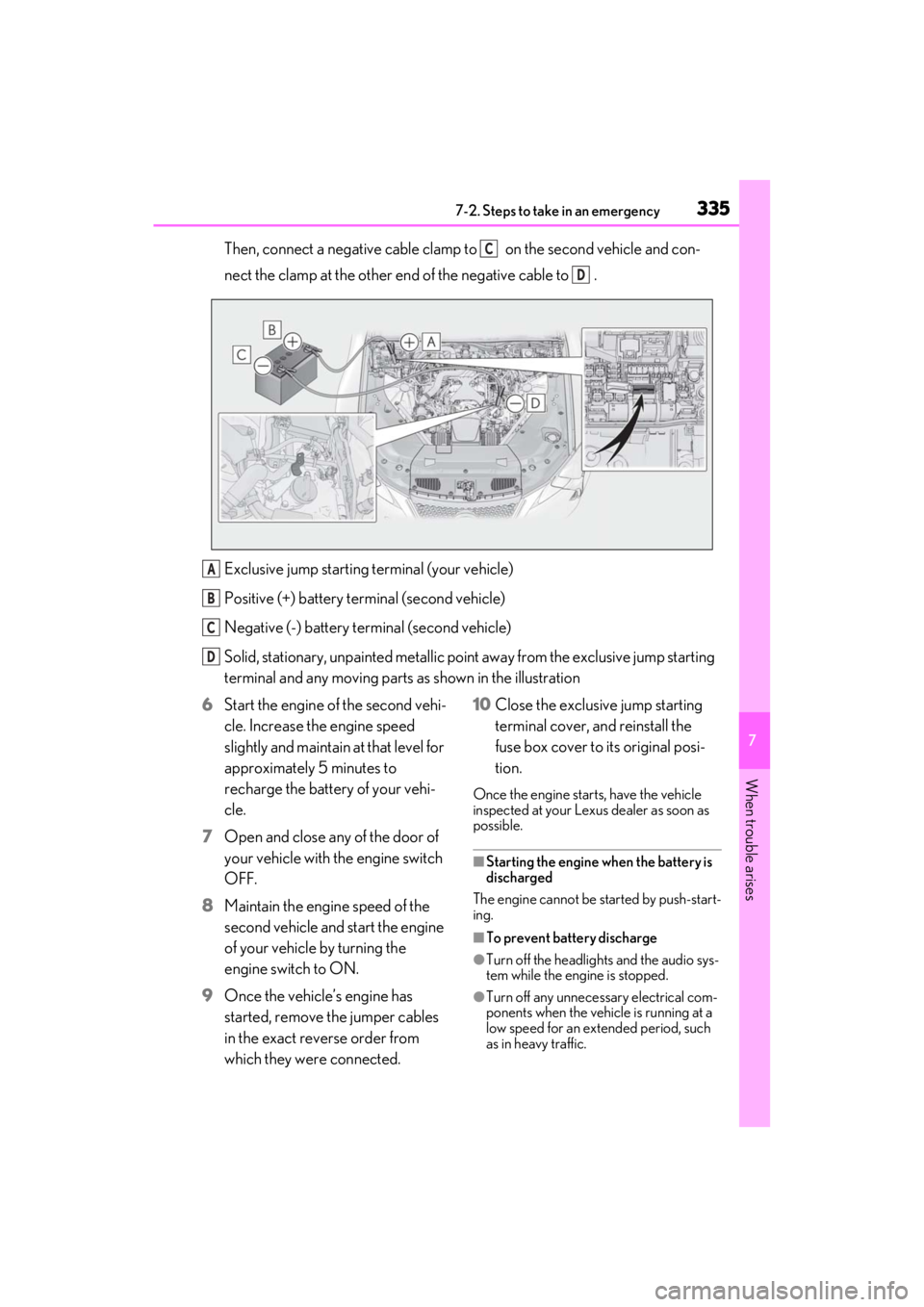
3357-2. Steps to take in an emergency
7
When trouble arises
Then, connect a negative cable clamp to on the second vehicle and con-
nect the clamp at the other end of the negative cable to .
Exclusive jump starting terminal (your vehicle)
Positive (+) battery terminal (second vehicle)
Negative (-) battery terminal (second vehicle)
Solid, stationary, unpainted metallic point away from the exclusive jump starting
terminal and any mo ving parts as shown in the illustration
6 Start the engine of the second vehi-
cle. Increase the engine speed
slightly and maintain at that level for
approximately 5 minutes to
recharge the battery of your vehi-
cle.
7 Open and close any of the door of
your vehicle with the engine switch
OFF.
8 Maintain the engine speed of the
second vehicle and start the engine
of your vehicle by turning the
engine switch to ON.
9 Once the vehicle’s engine has
started, remove the jumper cables
in the exact reverse order from
which they were connected. 10
Close the exclusive jump starting
terminal cover, and reinstall the
fuse box cover to its original posi-
tion.
Once the engine starts, have the vehicle
inspected at your Lexus dealer as soon as
possible.
■Starting the engine when the battery is
discharged
The engine cannot be started by push-start-
ing.
■To prevent battery discharge
●Turn off the headlights and the audio sys-
tem while the engine is stopped.
●Turn off any unnecessary electrical com-
ponents when the vehicle is running at a
low speed for an extended period, such
as in heavy traffic.
C
D
A
B
C
D
Page 338 of 410
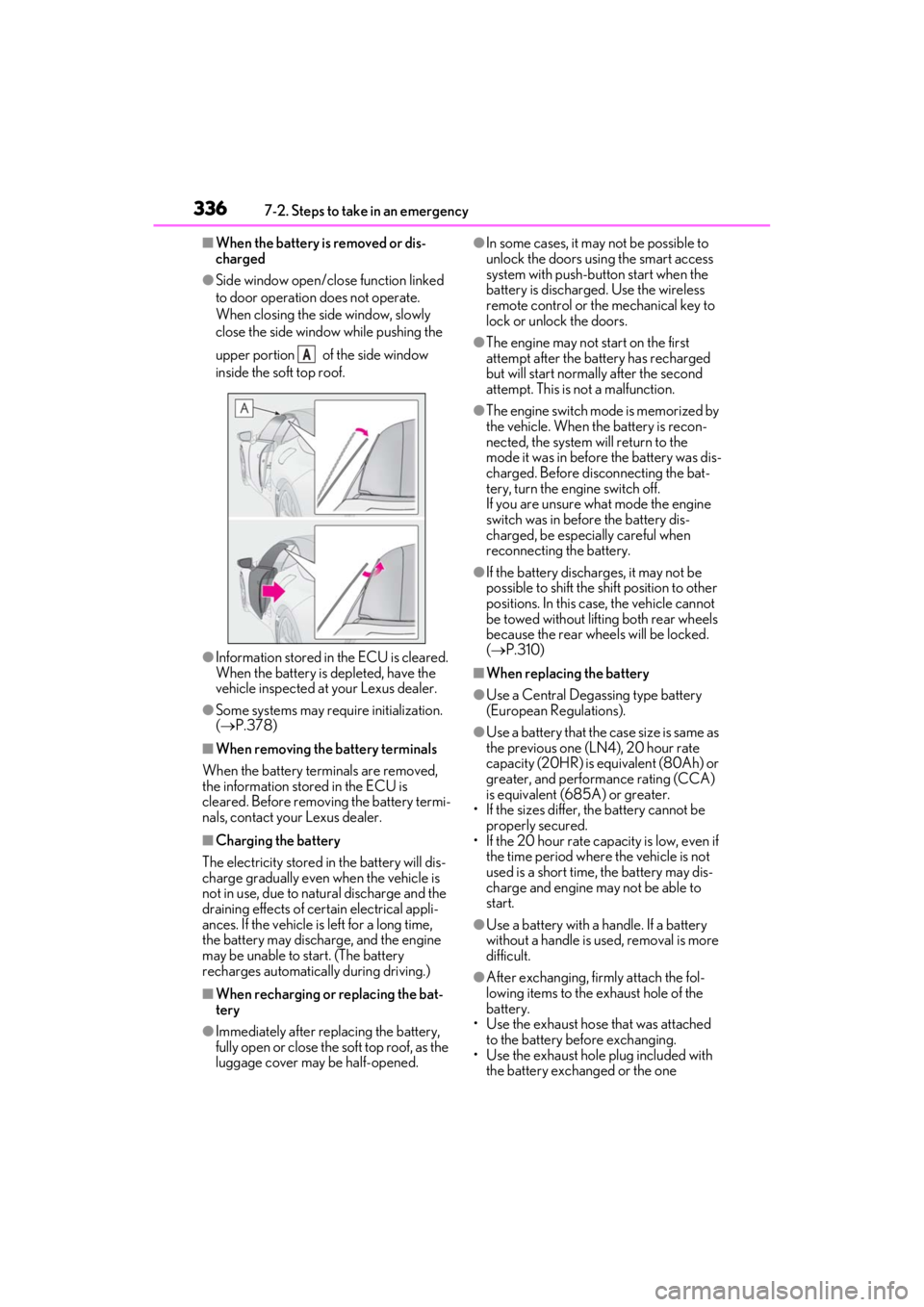
3367-2. Steps to take in an emergency
■When the battery is removed or dis-
charged
●Side window open/close function linked
to door operation does not operate.
When closing the side window, slowly
close the side window while pushing the
upper portion of the side window
inside the soft top roof.
●Information stored in the ECU is cleared.
When the battery is depleted, have the
vehicle inspected at your Lexus dealer.
●Some systems may require initialization.
( P.378)
■When removing the battery terminals
When the battery terminals are removed,
the information stored in the ECU is
cleared. Before removi ng the battery termi-
nals, contact your Lexus dealer.
■Charging the battery
The electricity stored in the battery will dis-
charge gradually even when the vehicle is
not in use, due to natural discharge and the
draining effects of certain electrical appli-
ances. If the vehicle is left for a long time,
the battery may discharge, and the engine
may be unable to start. (The battery
recharges automatically during driving.)
■When recharging or replacing the bat-
tery
●Immediately after replacing the battery,
fully open or close the soft top roof, as the
luggage cover may be half-opened.
●In some cases, it may not be possible to
unlock the doors using the smart access
system with push-button start when the
battery is discharged. Use the wireless
remote control or the mechanical key to
lock or unlock the doors.
●The engine may not start on the first
attempt after the battery has recharged
but will start normally after the second
attempt. This is not a malfunction.
●The engine switch mode is memorized by
the vehicle. When the battery is recon-
nected, the system will return to the
mode it was in before the battery was dis-
charged. Before disconnecting the bat-
tery, turn the engine switch off.
If you are unsure wh at mode the engine
switch was in before the battery dis-
charged, be especially careful when
reconnecting the battery.
●If the battery discharges, it may not be
possible to shift the shift position to other
positions. In this case, the vehicle cannot
be towed without lifting both rear wheels
because the rear wheels will be locked.
( P.310)
■When replacing the battery
●Use a Central Degassing type battery
(European Regulations).
●Use a battery that the case size is same as
the previous one (LN4), 20 hour rate
capacity (20HR) is eq uivalent (80Ah) or
greater, and performance rating (CCA)
is equivalent (685A) or greater.
• If the sizes differ, the battery cannot be
properly secured.
• If the 20 hour rate capacity is low, even if the time period where the vehicle is not
used is a short time, the battery may dis-
charge and engine may not be able to
start.
●Use a battery with a handle. If a battery
without a handle is used, removal is more
difficult.
●After exchanging, firmly attach the fol-
lowing items to the exhaust hole of the
battery.
• Use the exhaust hose that was attached to the battery before exchanging.
• Use the exhaust hole plug included with the battery exchanged or the one
A
Page 339 of 410
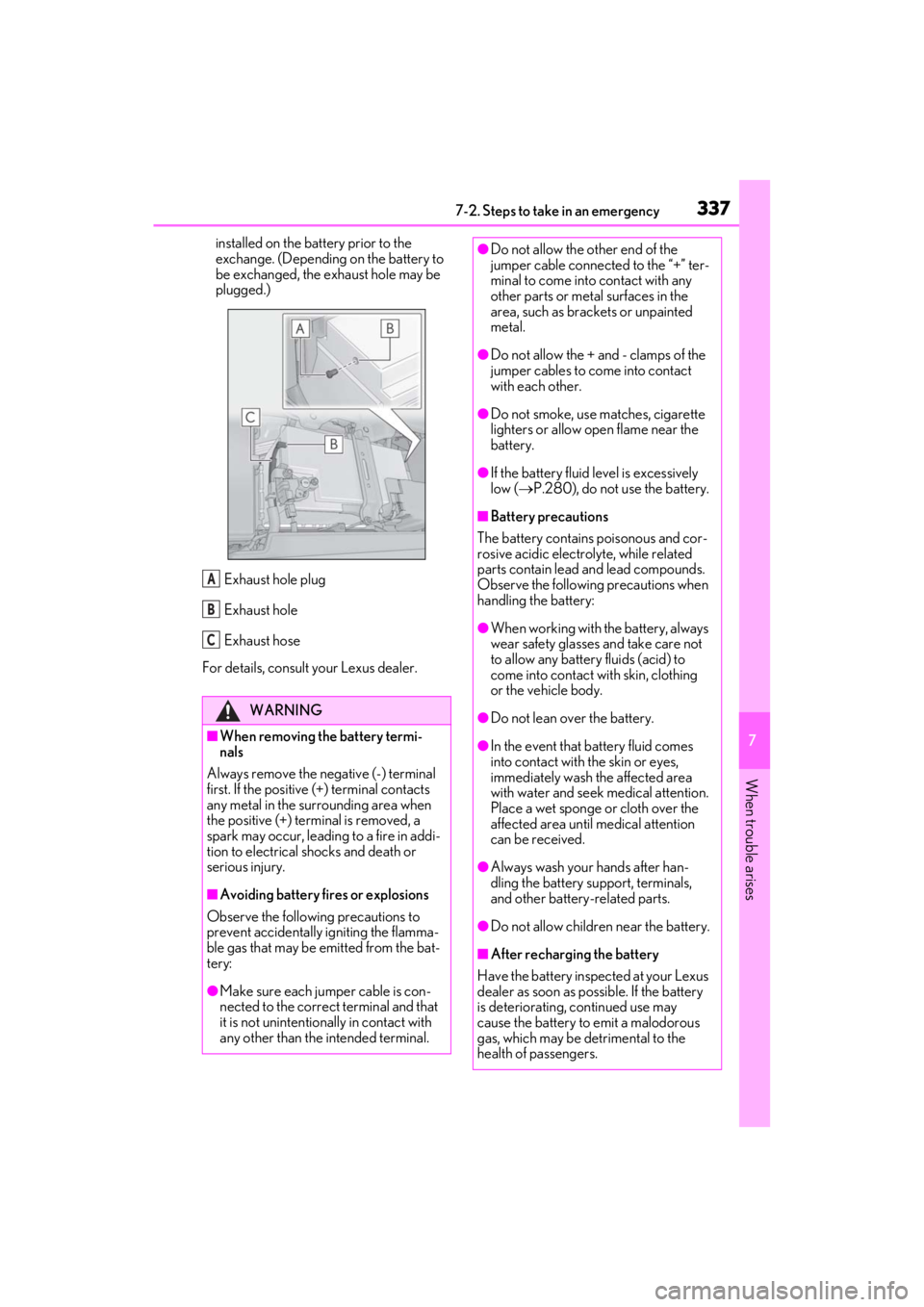
3377-2. Steps to take in an emergency
7
When trouble arises
installed on the battery prior to the
exchange. (Depending on the battery to
be exchanged, the exhaust hole may be
plugged.)Exhaust hole plug
Exhaust hole
Exhaust hose
For details, consult your Lexus dealer.
WARNING
■When removing the battery termi-
nals
Always remove the negative (-) terminal
first. If the positive (+) terminal contacts
any metal in the surrounding area when
the positive (+) terminal is removed, a
spark may occur, leadin g to a fire in addi-
tion to electrical shocks and death or
serious injury.
■Avoiding battery fires or explosions
Observe the following precautions to
prevent accidentally igniting the flamma-
ble gas that may be emitted from the bat-
tery:
●Make sure each jumper cable is con-
nected to the correct terminal and that
it is not unintentiona lly in contact with
any other than the intended terminal.
A
B
C
●Do not allow the other end of the
jumper cable connected to the “+” ter-
minal to come into contact with any
other parts or metal surfaces in the
area, such as brackets or unpainted
metal.
●Do not allow the + and - clamps of the
jumper cables to come into contact
with each other.
●Do not smoke, use matches, cigarette
lighters or allow open flame near the
battery.
●If the battery fluid level is excessively
low ( P.280), do not use the battery.
■Battery precautions
The battery contains poisonous and cor-
rosive acidic electrol yte, while related
parts contain lead and lead compounds.
Observe the following precautions when
handling the battery:
●When working with the battery, always
wear safety glasses and take care not
to allow any battery fluids (acid) to
come into contact with skin, clothing
or the vehicle body.
●Do not lean over the battery.
●In the event that battery fluid comes
into contact with the skin or eyes,
immediately wash the affected area
with water and seek medical attention.
Place a wet sponge or cloth over the
affected area until medical attention
can be received.
●Always wash your hands after han-
dling the battery support, terminals,
and other battery-related parts.
●Do not allow children near the battery.
■After recharging the battery
Have the battery inspected at your Lexus
dealer as soon as possible. If the battery
is deteriorating, continued use may
cause the battery to emit a malodorous
gas, which may be detrimental to the
health of passengers.
Page 340 of 410
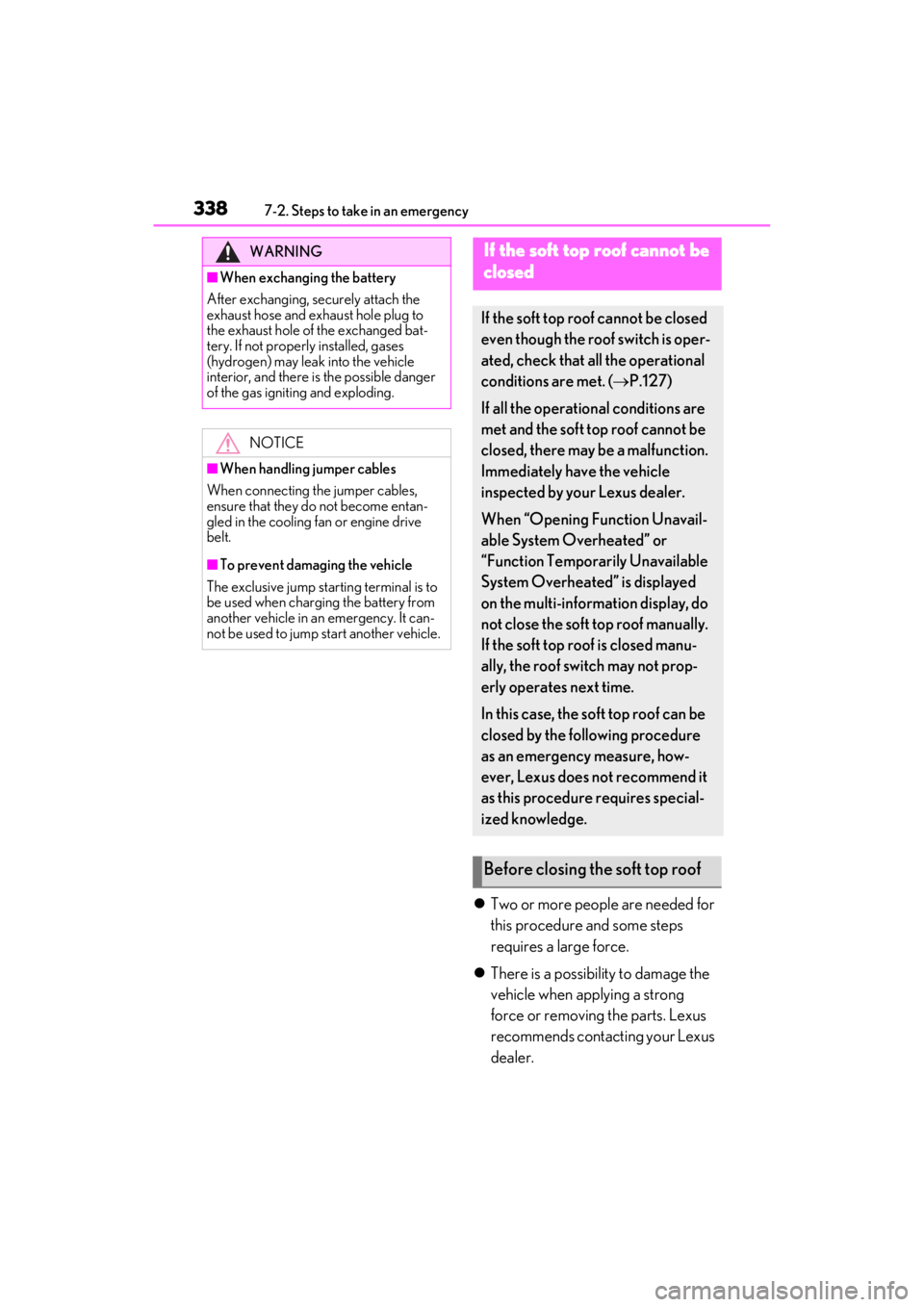
3387-2. Steps to take in an emergency
Two or more people are needed for
this procedure and some steps
requires a large force.
There is a possibility to damage the
vehicle when applying a strong
force or removing the parts. Lexus
recommends contact ing your Lexus
dealer.
WARNING
■When exchanging the battery
After exchanging, securely attach the
exhaust hose and exhaust hole plug to
the exhaust hole of the exchanged bat-
tery. If not properly installed, gases
(hydrogen) may leak into the vehicle
interior, and there is the possible danger
of the gas igniting and exploding.
NOTICE
■When handling jumper cables
When connecting the jumper cables,
ensure that they do not become entan-
gled in the cooling fan or engine drive
belt.
■To prevent damaging the vehicle
The exclusive jump starting terminal is to
be used when charging the battery from
another vehicle in an emergency. It can-
not be used to jump start another vehicle.
If the soft top roof cannot be
c
losed
If the soft top roof cannot be closed
even though the roof switch is oper-
ated, check that all the operational
conditions are met. ( P.127)
If all the operational conditions are
met and the soft top roof cannot be
closed, there may be a malfunction.
Immediately have the vehicle
inspected by your Lexus dealer.
When “Opening Function Unavail-
able System Overheated” or
“Function Temporarily Unavailable
System Overheated” is displayed
on the multi-information display, do
not close the soft top roof manually.
If the soft top roof is closed manu-
ally, the roof switch may not prop-
erly operates next time.
In this case, the soft top roof can be
closed by the following procedure
as an emergency measure, how-
ever, Lexus does not recommend it
as this procedure requires special-
ized knowledge.
Before closing the soft top roof
Page 341 of 410
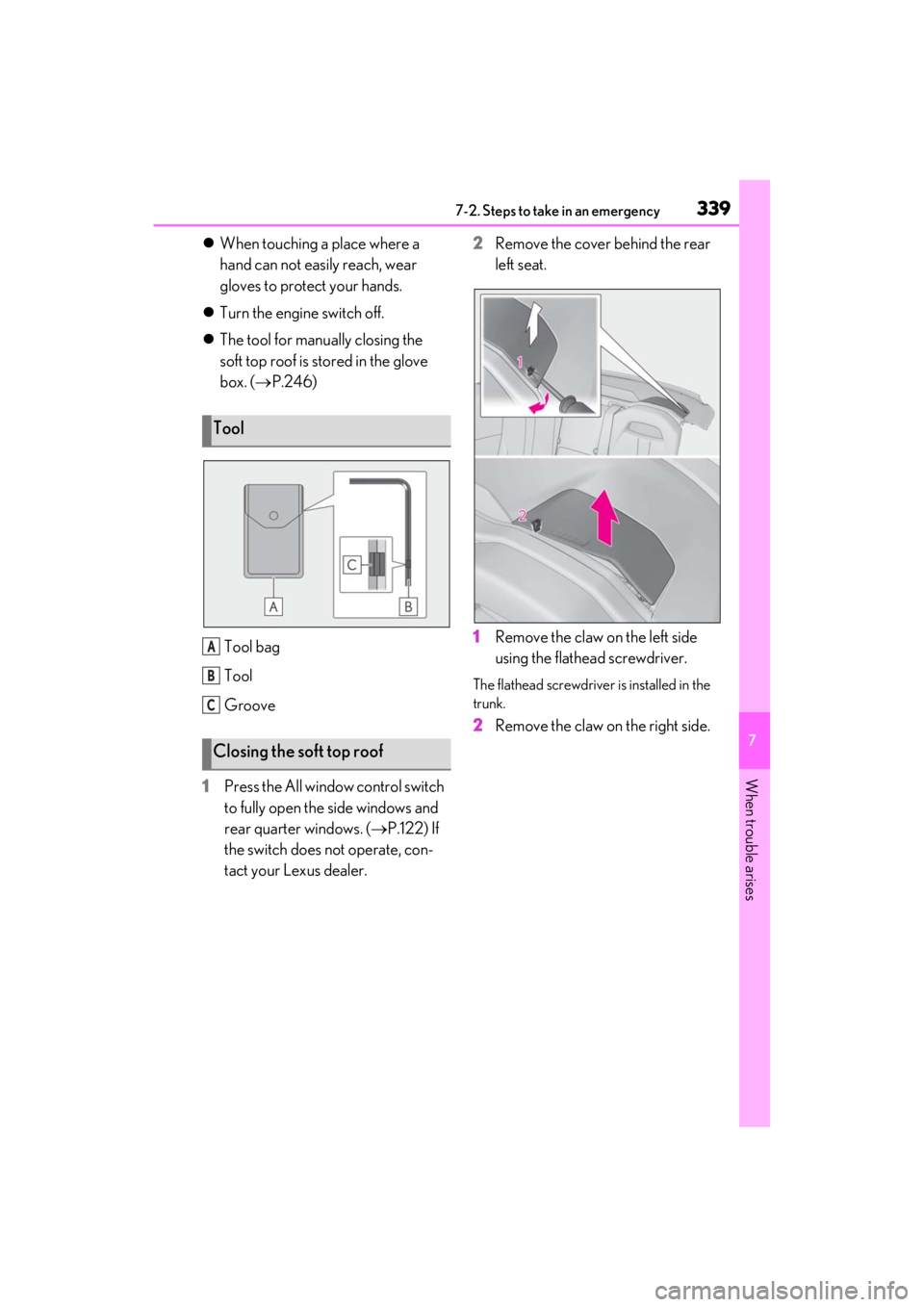
3397-2. Steps to take in an emergency
7
When trouble arises
When touching a place where a
hand can not easily reach, wear
gloves to protect your hands.
Turn the engine switch off.
The tool for manually closing the
soft top roof is stored in the glove
box. ( P.246)
Tool bag
Tool
Groove
1 Press the All window control switch
to fully open the side windows and
rear quarter windows. ( P.122) If
the switch does not operate, con-
tact your Lexus dealer. 2
Remove the cover behind the rear
left seat.
1 Remove the claw on the left side
using the flathead screwdriver.
The flathead screwdriver is installed in the
trunk.
2Remove the claw on the right side.
Tool
Closing the soft top roof
A
B
C
Page 344 of 410
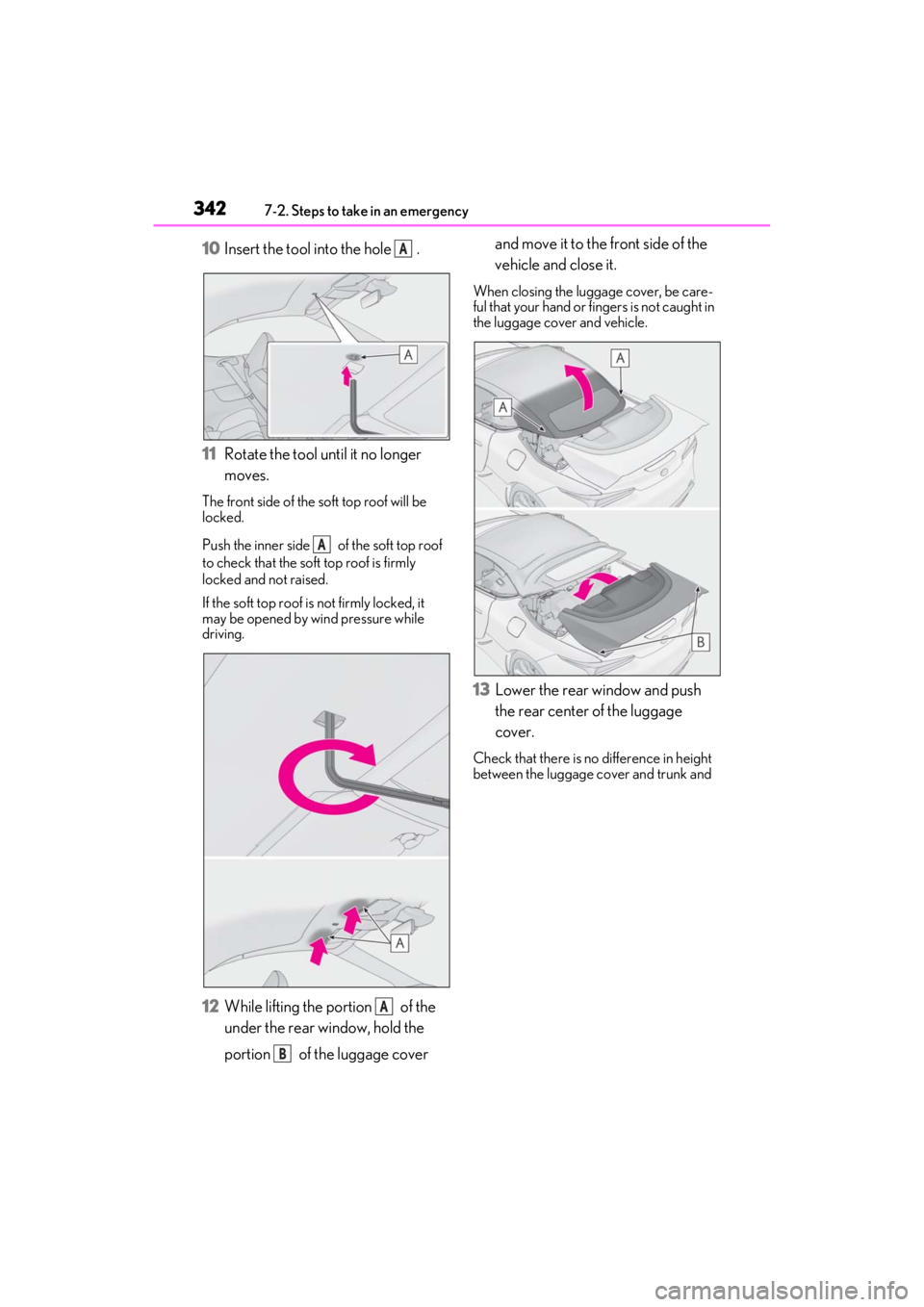
3427-2. Steps to take in an emergency
10Insert the tool into the hole .
11 Rotate the tool until it no longer
moves.
The front side of the soft top roof will be
locked.
Push the inner side of the soft top roof
to check that the soft top roof is firmly
locked and not raised.
If the soft top roof is not firmly locked, it
may be opened by wind pressure while
driving.
12While lifting the portion of the
under the rear window, hold the
portion of the luggage cover and move it to the front side of the
vehicle and close it.
When closing the luggage cover, be care-
ful that your hand or fi
ngers is not caught in
the luggage cover and vehicle.
13 Lower the rear window and push
the rear center of the luggage
cover.
Check that there is no difference in height
between the luggage cover and trunk and
A
A
A
B
Page 348 of 410
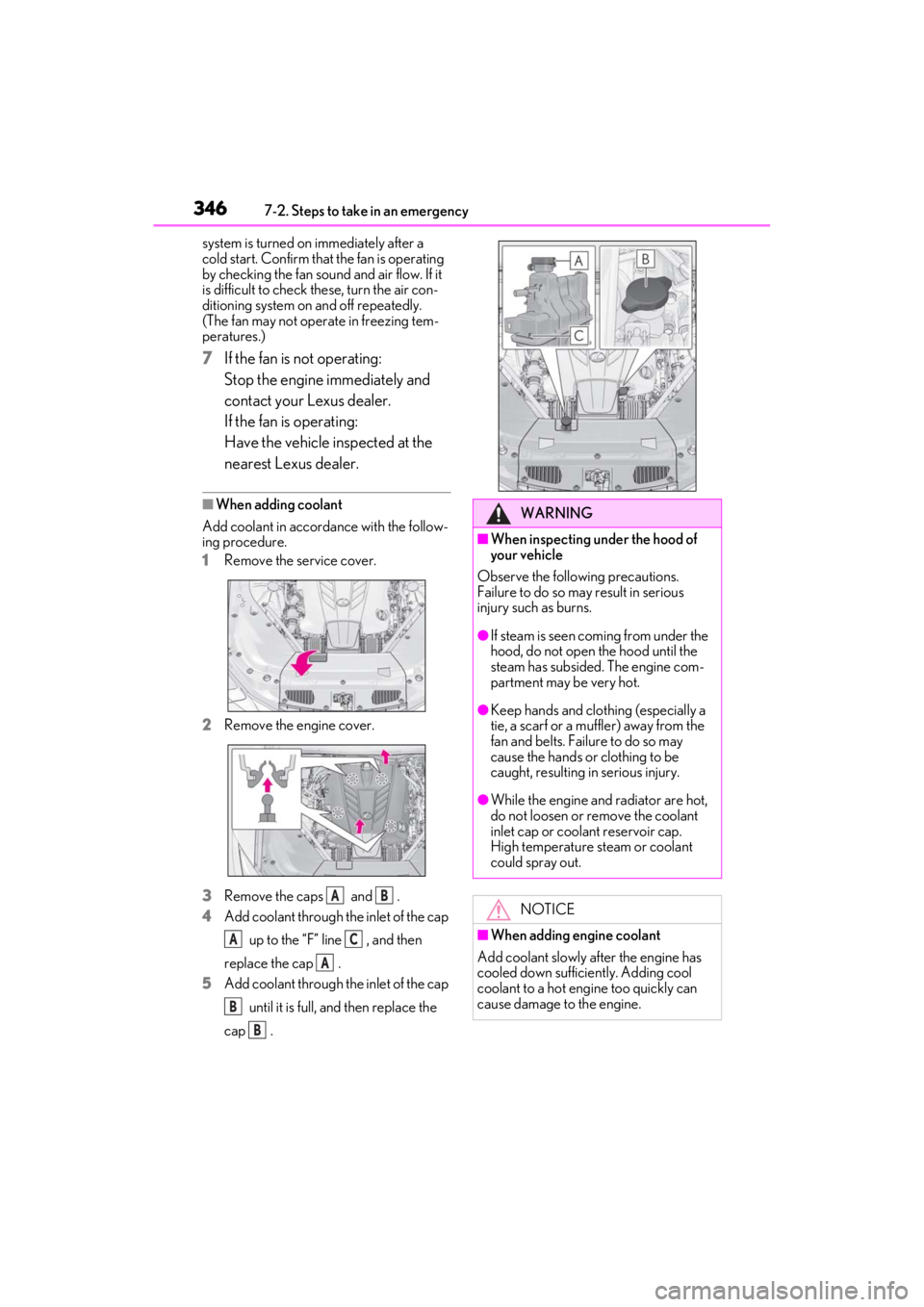
3467-2. Steps to take in an emergency
system is turned on immediately after a
cold start. Confirm that the fan is operating
by checking the fan sound and air flow. If it
is difficult to check these, turn the air con-
ditioning system on and off repeatedly.
(The fan may not operate in freezing tem-
peratures.)
7If the fan is not operating:
Stop the engine immediately and
contact your Lexus dealer.
If the fan is operating:
Have the vehicle inspected at the
nearest Lexus dealer.
■When adding coolant
Add coolant in accordance with the follow-
ing procedure.
1
Remove the service cover.
2
Remove the engine cover.
3
Remove the caps and .
4
Add coolant through the inlet of the cap
up to the “F” line , and then
replace the cap .
5
Add coolant through the inlet of the cap
until it is full, and then replace the
cap .
AB
AC
A
B
B
WARNING
■When inspecting under the hood of
your vehicle
Observe the following precautions.
Failure to do so may result in serious
injury such as burns.
●If steam is seen coming from under the
hood, do not open the hood until the
steam has subsided. The engine com-
partment may be very hot.
●Keep hands and clothing (especially a
tie, a scarf or a muffler) away from the
fan and belts. Failure to do so may
cause the hands or clothing to be
caught, resulting in serious injury.
●While the engine and radiator are hot,
do not loosen or remove the coolant
inlet cap or coolant reservoir cap.
High temperature steam or coolant
could spray out.
NOTICE
■When adding engine coolant
Add coolant slowly after the engine has
cooled down sufficiently. Adding cool
coolant to a hot engine too quickly can
cause damage to the engine.
Page 355 of 410
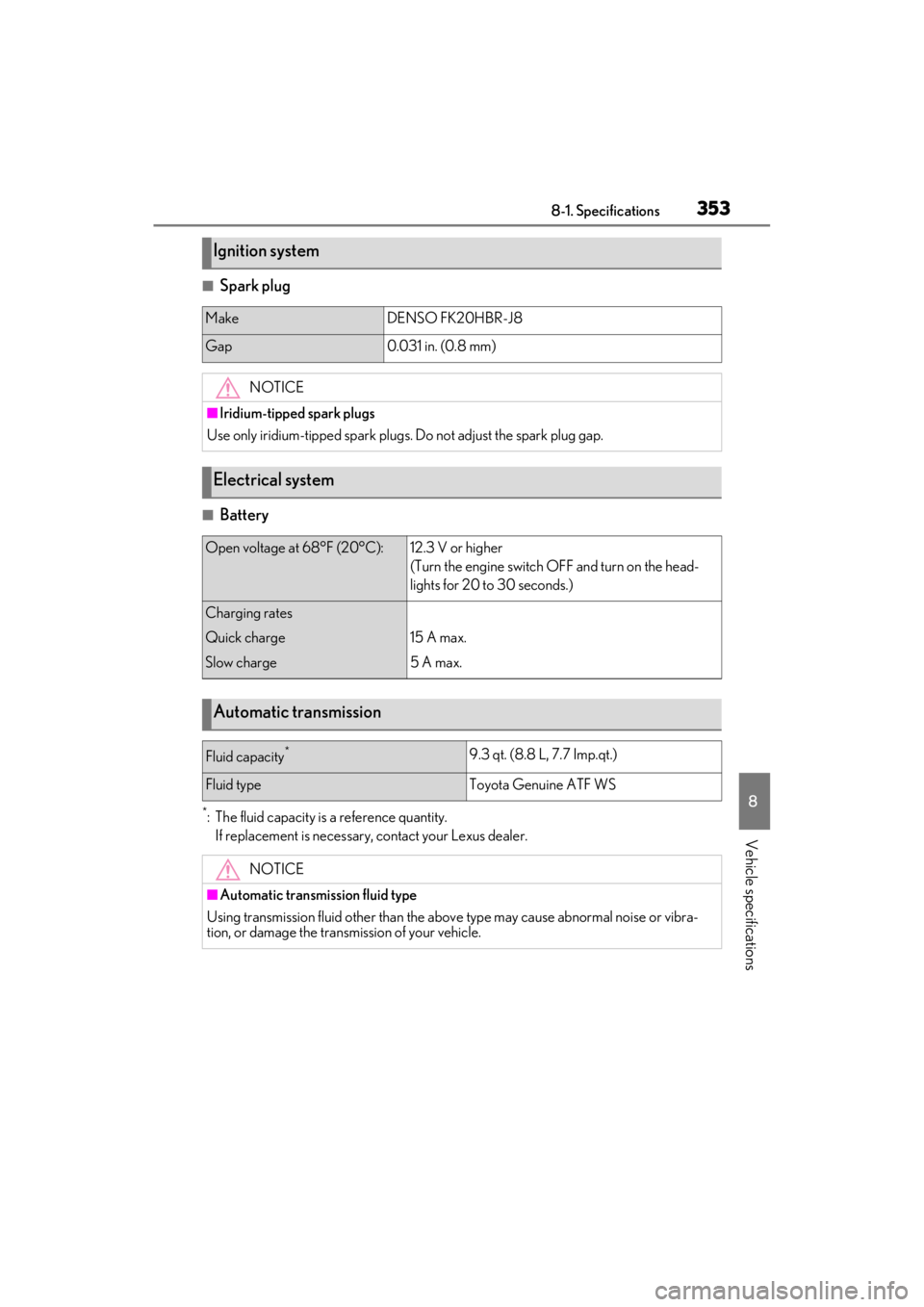
3538-1. Specifications
8
Vehicle specifications
■Spark plug
■Battery
*: The fluid capacity is a reference quantity.If replacement is necessary, contact your Lexus dealer.
Ignition system
MakeDENSO FK20HBR-J8
Gap0.031 in. (0.8 mm)
NOTICE
■Iridium-tipped spark plugs
Use only iridium-tipped spark plugs. Do not adjust the spark plug gap.
Electrical system
Open voltage at 68°F (20°C):12.3 V or higher
(Turn the engine switch OF F and turn on the head-
lights for 20 to 30 seconds.)
Charging rates
Quick charge
Slow charge
15 A max.
5 A max.
Automatic transmission
Fluid capacity*9.3 qt. (8.8 L, 7.7 Imp.qt.)
Fluid typeToyota Genuine ATF WS
NOTICE
■Automatic transmission fluid type
Using transmission fluid other than the above type may cause abnormal noise or vibra-
tion, or damage the transmission of your vehicle.
Page 359 of 410
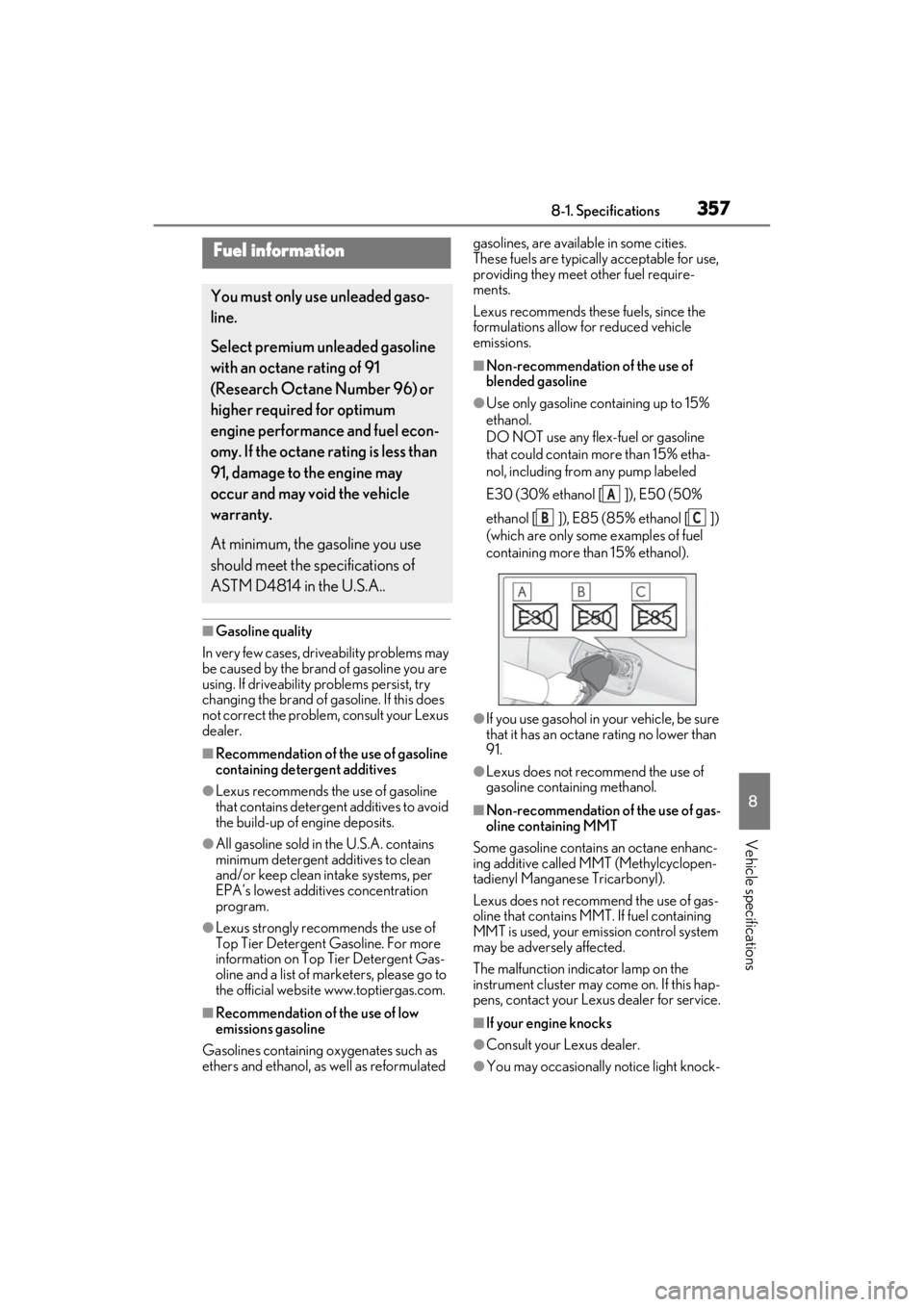
3578-1. Specifications
8
Vehicle specifications
■Gasoline quality
In very few cases, driveability problems may
be caused by the brand of gasoline you are
using. If driveability problems persist, try
changing the brand of gasoline. If this does
not correct the problem, consult your Lexus
dealer.
■Recommendation of the use of gasoline
containing detergent additives
●Lexus recommends the use of gasoline
that contains detergent additives to avoid
the build-up of engine deposits.
●All gasoline sold in the U.S.A. contains
minimum detergent additives to clean
and/or keep clean intake systems, per
EPA’s lowest additives concentration
program.
●Lexus strongly recommends the use of
Top Tier Detergent Gasoline. For more
information on Top Tier Detergent Gas-
oline and a list of marketers, please go to
the official websit e www.toptiergas.com.
■Recommendation of the use of low
emissions gasoline
Gasolines containing oxygenates such as
ethers and ethanol, as well as reformulated gasolines, are available in some cities.
These fuels are typically acceptable for use,
providing they meet other fuel require-
ments.
Lexus recommends these fuels, since the
formulations allow for reduced vehicle
emissions.
■Non-recommendation of the use of
blended gasoline
●Use only gasoline containing up to 15%
ethanol.
DO NOT use any flex-fuel or gasoline
that could contain more than 15% etha-
nol, including from
any pump labeled
E30 (30% ethanol [ ]), E50 (50%
ethanol [ ]), E85 (85% ethanol [ ])
(which are only some examples of fuel
containing more than 15% ethanol).
●If you use gasohol in your vehicle, be sure
that it has an octane rating no lower than
91.
●Lexus does not recommend the use of
gasoline containing methanol.
■Non-recommendation of the use of gas-
oline containing MMT
Some gasoline contains an octane enhanc-
ing additive called MMT (Methylcyclopen-
tadienyl Manganese Tricarbonyl).
Lexus does not recommend the use of gas-
oline that contains MMT. If fuel containing
MMT is used, your emission control system
may be adversely affected.
The malfunction indicator lamp on the
instrument cluster may come on. If this hap-
pens, contact your Lexus dealer for service.
■If your engine knocks
●Consult your Lexus dealer.
●You may occasionally notice light knock-
Fuel information
You must only use unleaded gaso-
line.
Select premium unleaded gasoline
with an octane rating of 91
(Research Octane Number 96) or
higher required for optimum
engine performance and fuel econ-
omy. If the octane ra ting is less than
91, damage to the engine may
occur and may void the vehicle
warranty.
At minimum, the gasoline you use
should meet the specifications of
ASTM D4814 in the U.S.A..
A
BC
Page 367 of 410

3658-1. Specifications
8
Vehicle specifications
Intended outboard
sidewall
(a) The sidewall that contains a whitewall, bears white lettering, or
bears manufacturer, brand, and/or model name molding that is
higher or deeper than the same molding on the other sidewall of the
tire, or
(b) The outward facing sidewall of an asymmetrical tire that has a
particular side that must always face outward when mounted on a
vehicle
Light truck (LT) tireA tire designated by its manufactur er as primarily intended for use
on lightweight trucks or mu ltipurpose passenger vehicles
Load ratingThe maximum load that a tire is rated to carry for a given inflation
pressure
Maximum load rat-
ingThe load rating for a tire at the maximum permissible inflation pres-
sure for that tire
Maximum permissi-
ble inflation pres-
sure
The maximum cold inflation pressure to which a tire may be inflated
Measuring rimThe rim on which a tire is fitted for physical dimension requirements
Open spliceAny parting at any junction of tread, sidewall, or innerliner that
extends to cord material
Outer diameterThe overall diameter of an inflated new tire
Overall width
The linear distance between the exteriors of the sidewalls of an
inflated tire, including elevations du e to labeling, decorations, or pro-
tective bands or ribs
Passenger car tire
A tire intended for use on passenger cars, multipurpose passenger
vehicles, and trucks, that have a gr oss vehicle weight rating (GVWR)
of 10,000 lb. or less.
PlyA layer of rubber-c oated parallel cords
Ply separationA parting of rubber compound between adjacent plies
Pneumatic tire
A mechanical device made of rubber, chemicals, fabric and steel or
other materials, that, when mounted on an automotive wheel, pro-
vides the traction and contains the gas or fluid that sustains the load
Radial ply tireA pneumatic tire in which the ply cords that extend to the beads are
laid at substantially 90 degree s to the centerline of the tread
Reinforced tireA tire designed to operate at high er loads and at higher inflation
pressures than the corre sponding standard tire
Tire related termMeaning